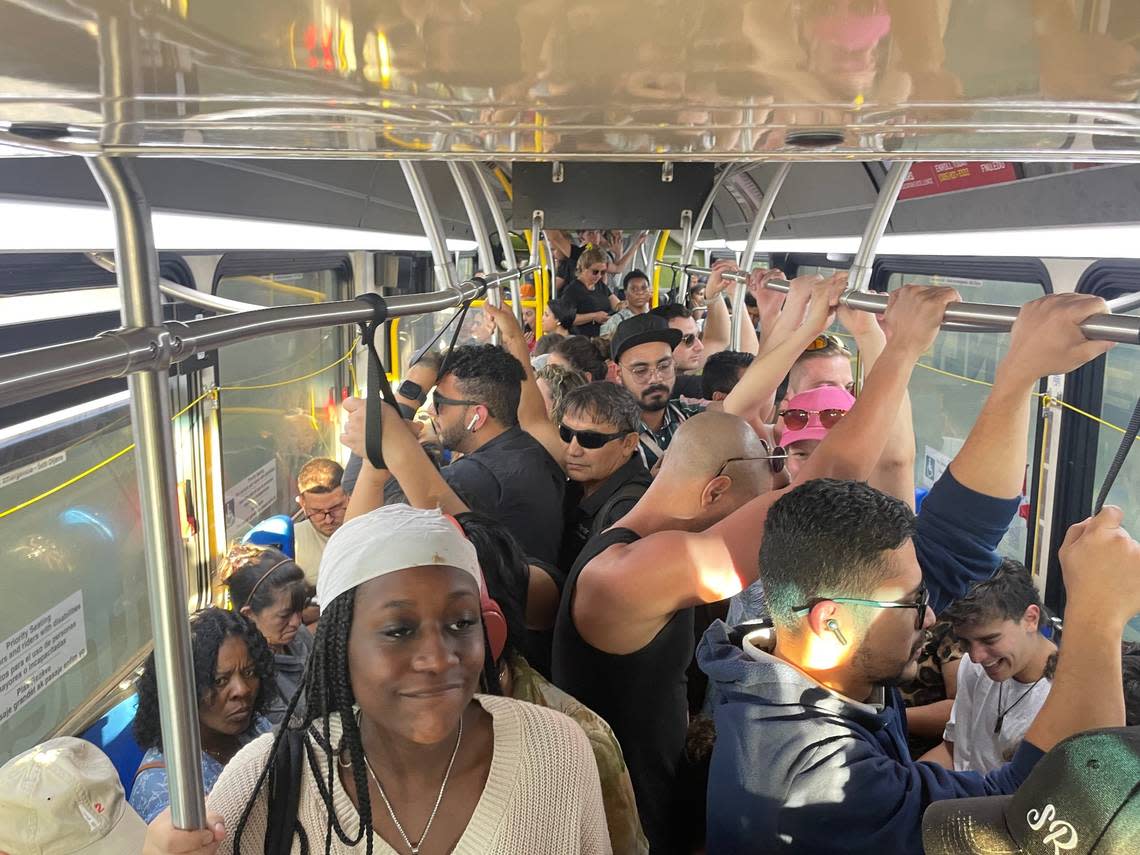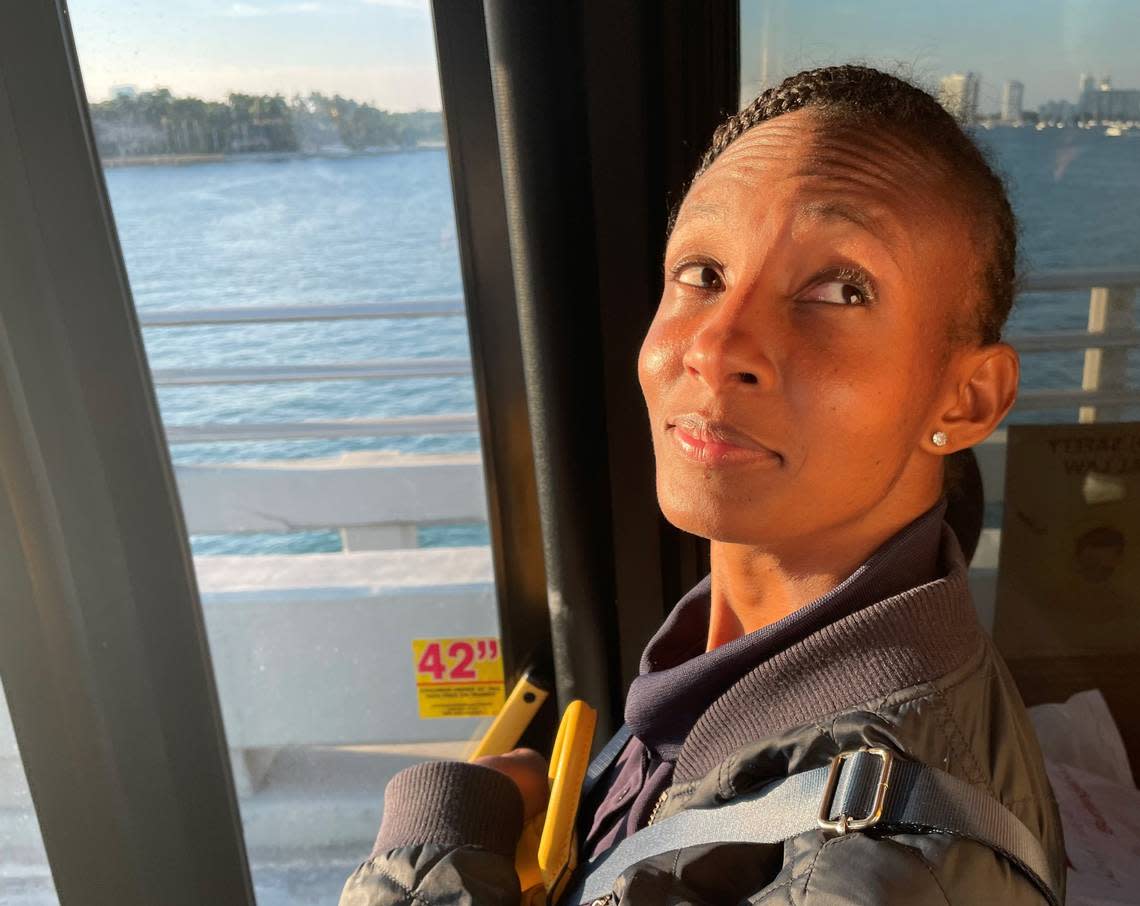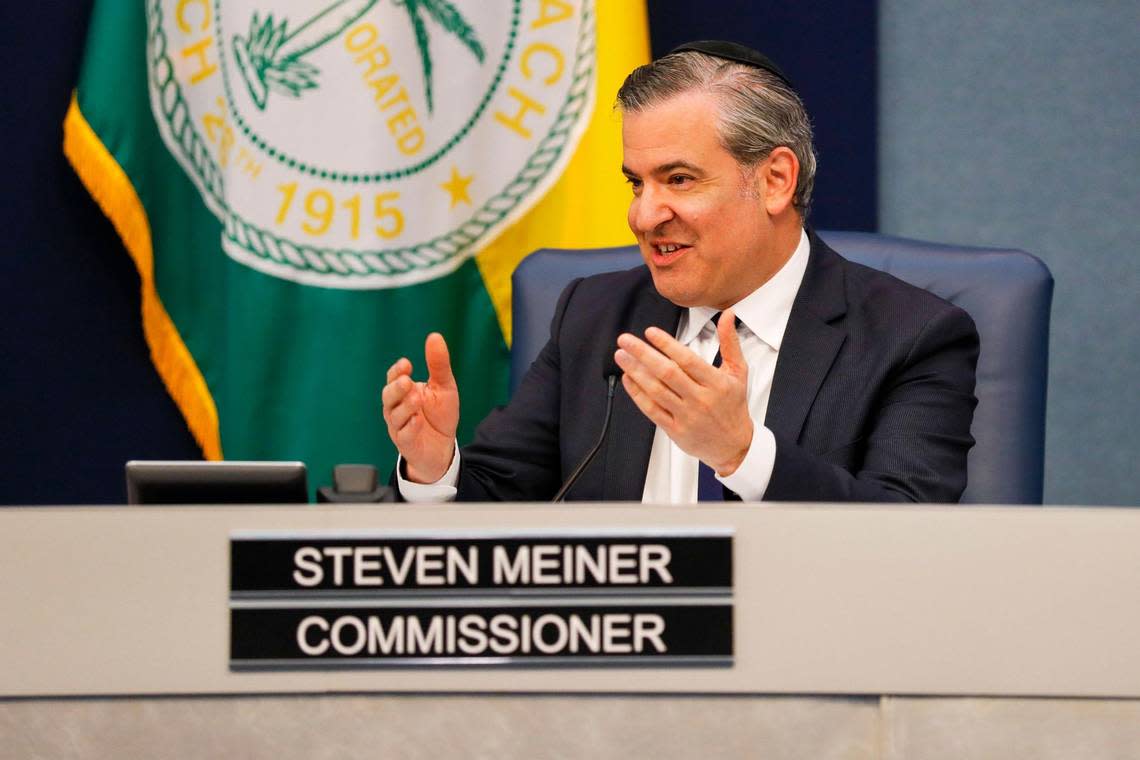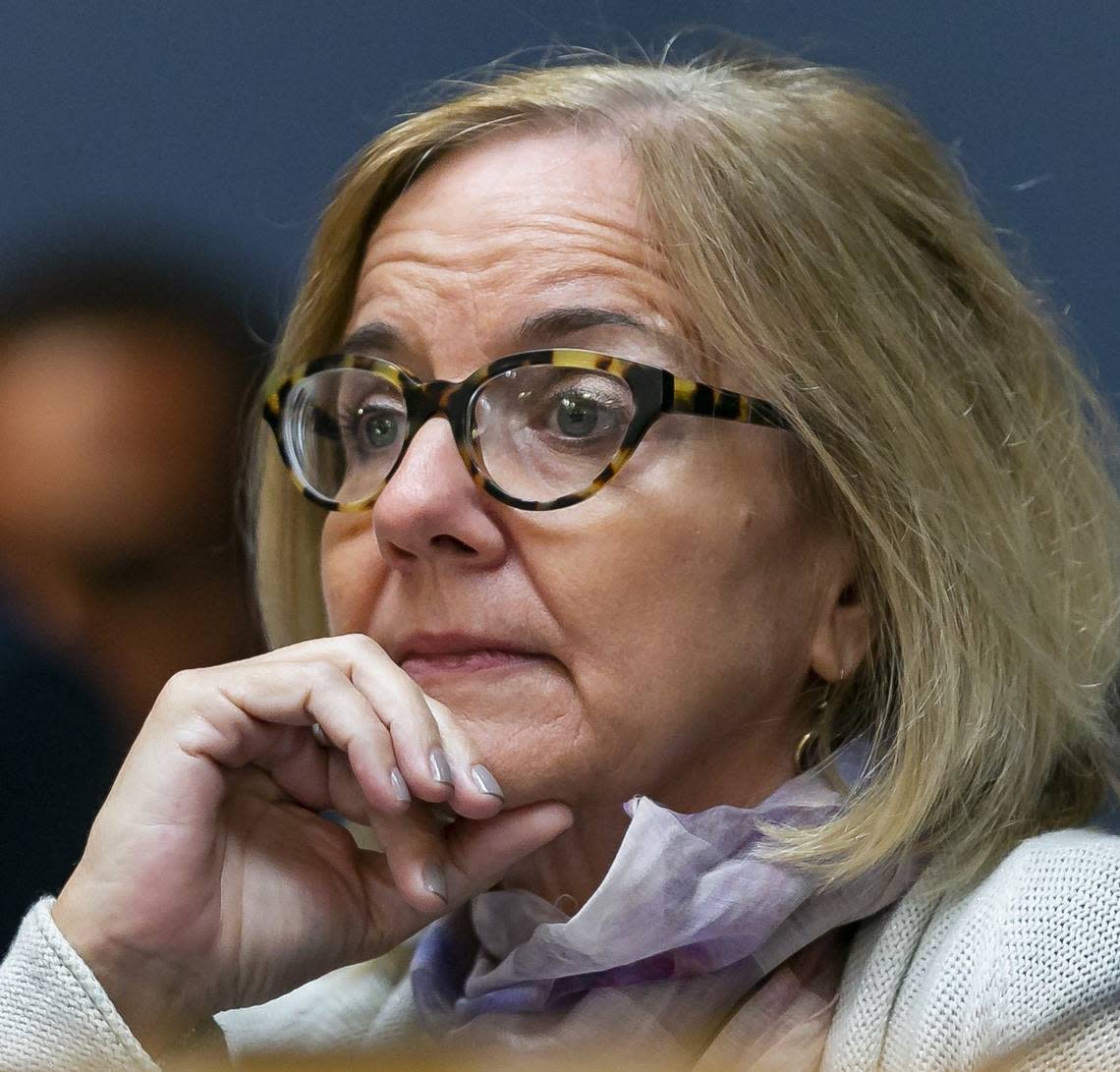‘Stop the train!’ South Beach buses are packed, but county’s rail plan under attack
One of the most popular bus routes in Miami-Dade County barely had room for Lakeisha Henry on a recent Wednesday rush hour as the 31-year-old maintenance worker squeezed herself into the standing area of a bus bound to Miami from South Beach.
“I never get a seat going home,” Henry said as she leaned against a plexiglass panel by the door on the No. 120 bus, joining about 80 other passengers for the stop-and-go ride over the MacArthur Causeway shortly after 5:30 pm. “Every day, it’s full.”
It’s a route that has been targeted for a train since the 1980s, a push for a “Baylink” transit extension that’s once again gaining momentum in county government but meeting resistance from some Miami Beach residents.
READ MORE: Miami-Dade mayor scraps monorail plan. Now pushing for Metromover extension to beach
After a proposed $1.3 billion monorail line fizzled over high costs last fall, Miami-Dade Mayor Daniella Levine Cava’s administration is preparing to solicit bids for extending the county’s Metromover trains four miles over the MacArthur and creating the first mass transit option for Miami Beach.

The administration estimates Metromover will be slightly cheaper than a monorail — about $1 billion in the early forecast — while providing the convenience of a “one-seat ride” from the county’s Metrorail station in downtown Miami to South Beach.
Similar efforts have died over the years. Miami-Dade’s first “Baylink” study was completed in 1988 as a way to speed travel over one of the busiest bridges on the county’s coast.
Costs have held back Miami-Dade’s transit system from expanding over the years, but the Metromover plan announced by Levine Cava and Miami-Dade Commissioner Eileen Higgins in a video message on Nov. 2 has hit opposition in and around Miami Beach as well.
“This is not unlike any hard decision,” said Higgins, whose district includes South Beach and parts of Miami. “There are always people who are opposed to something. But at the end of the day, we are living a traffic nightmare. And the only way to solve it is transit.”
Opposition at a town hall meeting
Blocks from where Henry boarded the packed bus, Higgins was jeered at a recent town hall in the lobby of a luxury condo building.
At one point, the audience in the community room of the Murano Grande, where apartments start above $1 million, chanted, “Stop the train!”
“They’re pushing this down our throats,” said John Stimmel, president of an owners association for a nearby condo tower, the Icon. It would face the elevated track that would carry the automated, rubber-wheeled Metromover along Fifth Street to stations on Lenox and Washington avenues.
Along with the quick pivot from monorail to Metromover, Stimmel said he sees Metromover as a “Trojan horse” that would bring looser county zoning rules around transit lines and benefit developers.
He also cited congestion from more visitors arriving in South Beach by train, the potential for crime and graffiti around the pylons built to support the Metromover tracks, and the risks some residents see in easier travel from Miami on the county’s only free transit option.

“People are afraid it’s going to bring in more crime,” he said. “Miami has a much worse homeless problem than Miami Beach does. I think this is going to exacerbate Miami Beach’s homeless program.”
Miami Beach’s approval isn’t needed for the Metromover project, currently set to be funded with county and state dollars and under Miami-Dade control.
But the opposition from affluent neighborhoods along the proposed route set up the possibility of well-funded legal challenges even if the Miami Beach loop for the Metromover gets the green light.
Fisher Island, where residents depend on a ferry station off the MacArthur, has lawyers reviewing Miami-Dade’s environmental studies needed for federal approval of the project. In a Feb. 16 letter, Fisher Island lawyer Lawson Fite warned of “significant shortcomings in the environmental analysis.”
“We are totally in favor of alleviating traffic on the causeway,” said Jim Ferraro, a lawyer and Fisher Island resident and a director for the owners’ association. “Our concern is this has been put together in a haphazard fashion.”
Miami-Dade commissioners approved a Baylink project for monorail in 2020, launching engineering and environmental work the county says can be used for Metromover as well, because both involve automated rubber-wheeled vehicles.
Miami-Dade’s Transportation and Public Works Department expects to have a request for bids ready this year, with a final commission decision set for 2024.
Tough transit crowd at this luxury South Beach condo tower where @CommishEileen and transit chief Eulois Cleckley are making the case for Metromover to the Beach. “Stop the train!” “Stop the train!” pic.twitter.com/KwiANuSbLw
— Doug Hanks (@doug_hanks) February 9, 2023
Miami Beach city commission wants to see more
Miami Beach commissioners on Feb. 22 balked at supporting the plan, opting to wait for the county to spend more time making its case and providing information to the public.
“We don’t even know what the potential zoning implications could be,” Commissioner Steven Meiner said. “That gets very concerning to me.”
Miami-Dade does impose its own zoning rules on some land near rapid-transit routes, but Higgins said the exemption for historic districts and other restrictions would mean virtually no change in development caps in South Beach.
Matthew Gultanoff was with a group of residents at the meeting wearing yellow “Build the Train” T-shirts.
A founder of Better Streets Miami Beach, he sees a wealthy elite trying to defeat a transit upgrade that’s going to be popular with the average city resident leery of traffic and parking needed to get to downtown Miami.
“It’s an amenity,” the nonprofit executive said. “Instead of rolling the dice and it maybe taking an hour to go a couple of miles, you could effortlessly go downtown and see a Heat game, and enjoy the arts and the culture.”
In 2004, Miami Beach voters endorsed a light-rail system over the MacArthur that would have operated at street level without elevated tracks. But the project never advanced.
The development group behind the monorail proposal circulated a poll from September showing 65% of Miami Beach voters would support the transit link and 29% opposed.

Some Miami Beach residents are in favor
While she got a hostile reception at the meeting in the “South of Fifth” neighborhood, Higgins noted the project got an endorsement from the association representing residents on the other side of the street, in the less affluent enclave of Flamingo Park.
“Many of them live car-free,” Higgins said. “Or they want to live car-free.”
The latest ridership figures show the county’s most popular bus route, the S, runs over the MacArthur Causeway, with an average 10,000 boardings daily for the trip between Miami’s Government Center Metrorail station and the Aventura Mall. The 120 bus that Henry took landed at No. 5 on the list, with about 7,000 daily boardings.
Demand for trips to Miami transit hubs are so high during rush hour in South Beach that buses regularly hit capacity and won’t stop for passengers, riders said.
When Maria Jimenez’s bus arrived at the corner of Fifth and Lenox Avenue shortly after 4:30 p.m., a wag of the driver’s finger signaled she shouldn’t even bother standing up from her bench. “Every day it is full,” the 63-year-old hotel housekeeper said as she waited for the first of three buses she needs to get home in Miami.
For Henry, who works on the maintenance crew for a condo high rise in South Beach, the bus ride over the MacArthur is the most unreliable part of her commute. Once she gets to Miami, Henry takes a Metrorail train north to her home in Miami.

On this day, it took about 40 minutes to make the five-mile trip to Government Center. The county estimates the same ride on Metromover would take about 15 minutes, linking South Beach with both the existing Metrorail system and the planned Tri-Rail station scheduled to open later this year in the same downtown transit hub.
Henry, a mother of school-age children, said she’d welcome the chance to catch a train riding above the traffic between her and Metrorail. “I could get home on time,” she said.
